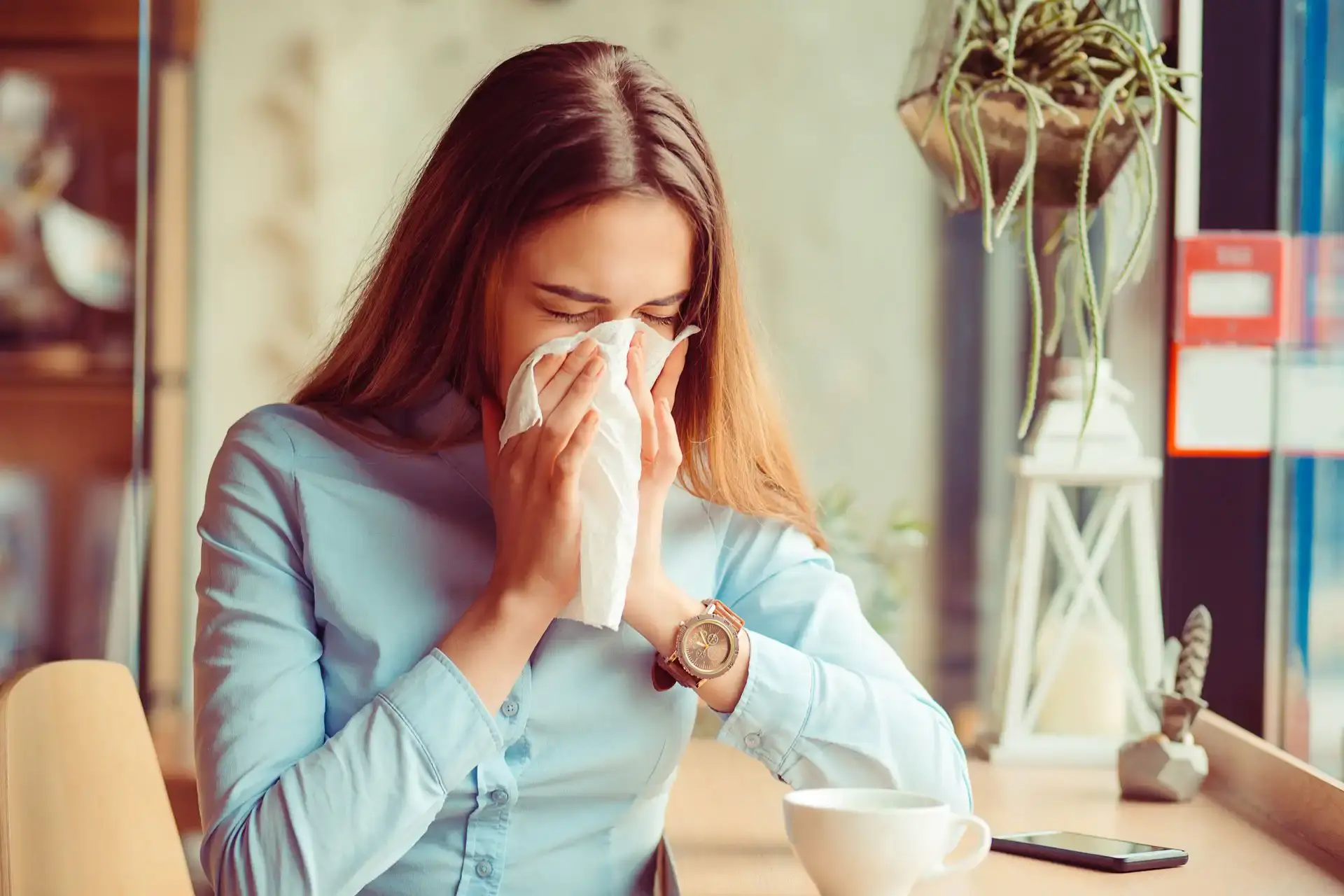What Causes Indoor Allergies?
Allergies are a reaction to a typically harmless substance, known as an allergen. When you come in contact with an allergen, your body’s immune system perceives it as an invader and tries to eliminate it. Specialized immune cells release the chemical histamine, which causes inflammation and pesky allergy symptoms.1,2
Indoor allergies can be caused by a number of allergens found in our homes. Sometimes, even allergens brought in from the outdoors can cause problems. These can include:
Dust and dust mites: Dust and tiny insects known as dust mites can trigger your allergies. They like to live in warm, humid environments, and they feed on dead skin flakes that we shed every day.3
Pet dander: Dander, or dead skin flakes from pets, often causes pet-related allergies. Other allergens include urine and saliva — fur or hair from pets does not cause allergies. Pets that have been outdoors can also bring in pollen and dust on their fur, which can also set off allergies.4
Mold: Mold and mildew form spores (similar to pollen grains) that, when inhaled, trigger allergies in some people. They like to grow in damp rooms around your home, such as the bathroom, kitchen, basement, and laundry room.5
Indoor Allergy Symptoms
Indoor allergy symptoms are similar to other types of allergies and are the result of histamine released in the body. This makes blood vessels leaky, leading to symptoms such as:
Runny or stuffy nose
Sneezing
Itchy, watery eyes
For those with asthma, indoor allergies can be difficult to deal with. The same triggers that set off allergy symptoms may also cause asthma symptoms. This is known as allergic asthma or allergy-induced asthma.6
How To Reduce Indoor Allergies
Indoor allergies can be tough to deal with, especially in your own home. Here we’ll discuss some tips on how to reduce allergies indoors, including cleaning regularly, using air filters, and changing clothes when coming inside.
1. Vacuum and Clean Your Home Regularly
Cleaning and vacuuming regularly can help keep all kinds of allergens under control in your home. Wipe down surfaces, along with any knickknacks on shelves to keep away dust and dander. Vacuum carpets and upholstered furniture weekly. Consider getting a vacuum with a high-efficiency particulate air (HEPA) filter to capture allergens. Wash curtains seasonally in hot water and dry on high heat to remove any built-up dust or dander in them.8
2. Use an Air Filter to Capture Airborne Allergens
HEPA filters are a great air filter for allergies because they can remove up to the majority of pollen, dust, and other airborne allergens from a room. Depending on your needs, you can invest in an air purifier for one room or your entire central air system. When buying an air purifier for one room, check to make sure it comes with a HEPA filter and has a clean air delivery rate (CADR) for the size of the room you put it in. If you have a central air system, you can replace the air filter with a high minimum efficiency reporting value (MERV) to keep the air clean. The higher the MERV rating is for a filter, the finer particles it will filter out.9
3. Wear a Mask When Cleaning Around the House
If you find yourself itching and sneezing when cleaning the house, you may benefit from wearing a mask. Masks help filter out particles that are too large to fit through the fabric. Pollen grains range from 10 to 100 micrometers — both surgical and N95 masks can filter these out, along with dust and dander. It’s important to note that wearing a mask won’t prevent eye allergy symptoms, such as itchy, watery eyes.10
4. Find and Clear Mold Around Your House
If you find mold or mildew around your home, the best thing to do is clean it right away. Always wear a mask and rubber gloves when cleaning mold or mildew — even if you don’t have a mold allergy — to avoid contact with cleaning chemicals. You can spray straight vinegar onto the walls and let it air dry or mix 2 cups of vinegar with 2 cups of hot water, 2 cups of borax, and ½ cup of salt. Apply the solution to the affected area and leave it for 30 minutes — afterward, reapply the solution and then scrub the area with a brush, and rinse with water. To prevent mold and prevent it from growing back, consider getting a dehumidifier to limit moisture in the air.8
5. Use a Dehumidifier to Reduce Moisture
In moist areas of your house, consider adding a dehumidifier to help prevent mold and mildew and to treat dust mites. These appliances help remove moisture from the air to keep surfaces dry. Remember to clean the water tank regularly to prevent more mold or mildew growth. The best indoor humidity level for allergies is between 40% to 50%.11
6. Wash Bedding and Dry on Hot Regularly
To help limit dust, dust mites, and pet dander, try to wash your bedding weekly in hot water (130°F) and then dry in a hot dryer. This heat will kill off dust mites and remove other allergens. For fabrics that are difficult to wash — like pillows, box springs, and mattresses — use zippered dust or allergen covers to keep out mites.12
7. Change Clothes and Shoes When Coming Inside
Depending on the time of year, the outdoors can be full of allergens like pollen and dust. If you’re outside for an extended period of time, these allergens can stick to your clothes and follow you back into your home. Once you get home, it’s best to remove your shoes outside or near the door and change clothes as soon as possible. Put your dirty clothes in a separate space to prevent the allergens from spreading around. For more tips on managing your outdoor allergies, check out our guide here.
8. Close Your Windows to Keep Out Pollen
Blooming trees and plants in the warm months fill the air with pollen, and if you have a pollen allergy, you’ll want to keep it outside. Avoid opening your windows and using window fans during pollen season where you live to prevent it from entering your home. If you would like to open your windows, check the pollen count for the day beforehand. You can also use air conditioning or fans instead to circulate air throughout your home — this can also help limit mold and mildew growth.13
9. Try Nasal Irrigation to Promote Healthy Sinuses
If your allergies are causing nasal congestion, you can use nasal irrigation to clean them out. This technique uses distilled water or saline solution to wash and moisten the sinuses, removing allergens and mucus. Different nasal irrigation devices include neti pots, squeeze bottles, and bulb syringes. Be sure to properly clean these devices after each use to prevent bacterial growth, as this can lead to a potentially serious infection.12 For more tips on treating nasal congestion, you can read more here.
10. Use BENADRYL® to Help With Indoor Allergies
Along with the above tips, use BENADRYL® products to relieve your allergy symptoms at the source. BENADRYL® products are over-the-counter antihistamine medications that can help alleviate your runny nose, watery eyes, and itchy throat. Use BENADRYL® Allergy ULTRATABS® and BENADRYL® Allergy Dye-Free LIQUI-GELS® to help kick your allergy symptoms to the curb. For allergies plus nasal and sinus congestion, try BENADRYL® Allergy Plus Congestion.
References
Cleveland Clinic. Allergy Overview. November 30, 2020. Accessed from: https://my.clevelandclinic.org/health/diseases/8610-allergy-overview
MedlinePlus. Histamine: The Stuff Allergies are Made of. September 8, 2017. Accessed from: https://medlineplus.gov/medlineplus-videos/histamine-the-stuff-allergies-are-made-of/
Asthma and Allergy Foundation of America. Dust Mite Allergy. October 2015. Accessed from: https://www.aafa.org/dust-mite-allergy/
Asthma and Allergy Foundation of America. Pet Allergy: Are You Allergic to Dogs or Cats? October 2015. Accessed from: https://www.aafa.org/pet-dog-cat-allergies/
Asthma and Allergy Foundation of America. Mold Allergy. October 2015. Accessed from: https://www.aafa.org/mold-allergy/
Mayo Clinic. Allergies and asthma: They often occur together. May 14, 2021. Accessed from: https://www.mayoclinic.org/diseases-conditions/asthma/in-depth/allergies-and-asthma/art-20047458
Mayo Clinic. Anaphylaxis. October 2, 2021. Accessed from: https://www.mayoclinic.org/diseases-conditions/anaphylaxis/symptoms-causes/syc-20351468
American Academy of Allergy, Asthma, & Immunology. Cleaning Tips for Allergy and Asthma Sufferers. September 28, 2020. Accessed from: https://www.aaaai.org/tools-for-the-public/conditions-library/allergies/cleaning-tips-for-allergy-and-asthma-sufferers
American College of Allergy, Asthma, & Immunology. Air Filters. Accessed from: https://acaai.org/allergies/management-treatment/living-with-allergies/air-filters/
UCLA Health. Seasonal allergies? Wear your face mask for relief. June 11, 2021. Accessed from: https://connect.uclahealth.org/2021/06/11/seasonal-allergies-wear-your-face-mask-for-relief/
American Academy of Allergy, Asthma, & Immunology. Humidifiers and indoor allergies. September 28, 2020. Accessed from: https://www.aaaai.org/tools-for-the-public/conditions-library/allergies/humidifiers-and-indoor-allergies
American Academy of Allergy, Asthma, & Immunology. Indoor Allergens. September 28, 2020. Accessed from: https://www.aaaai.org/tools-for-the-public/conditions-library/allergies/indoor-allergens-ttr
Asthma and Allergy Foundation of America. Control Indoor Allergens to Improve Indoor Air Quality. September 2015. Accessed from: https://www.aafa.org/control-indoor-allergens/
Food and Drug Administration. Is Rinsing Your Sinuses With Neti Pots Safe? August 4, 2021. Accessed from: https://www.fda.gov/consumers/consumer-updates/rinsing-your-sinuses-neti-pots-safe


